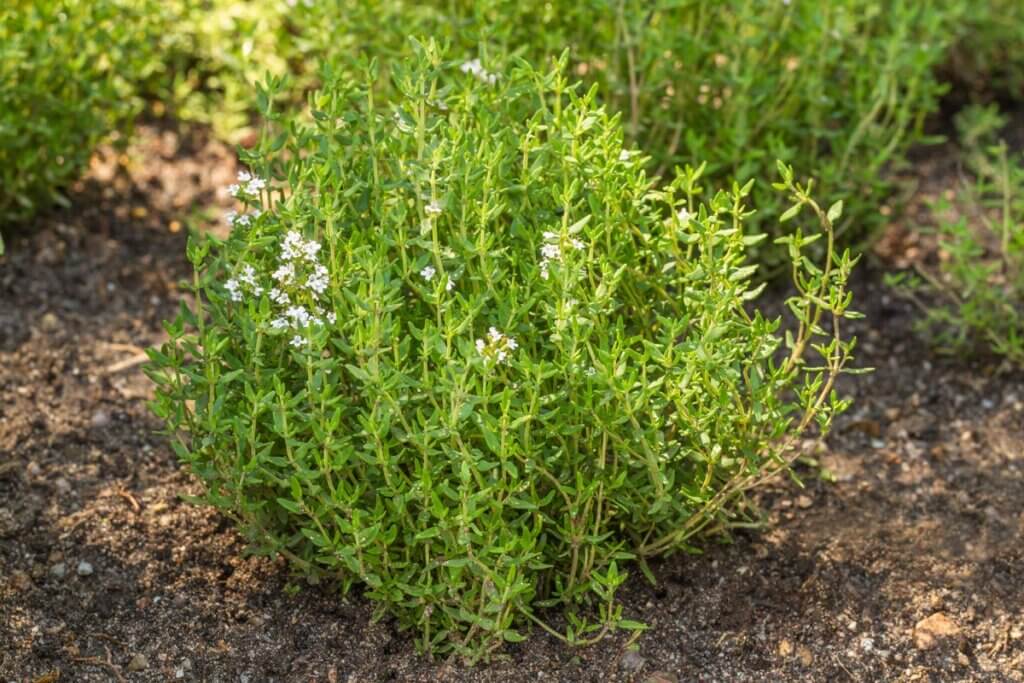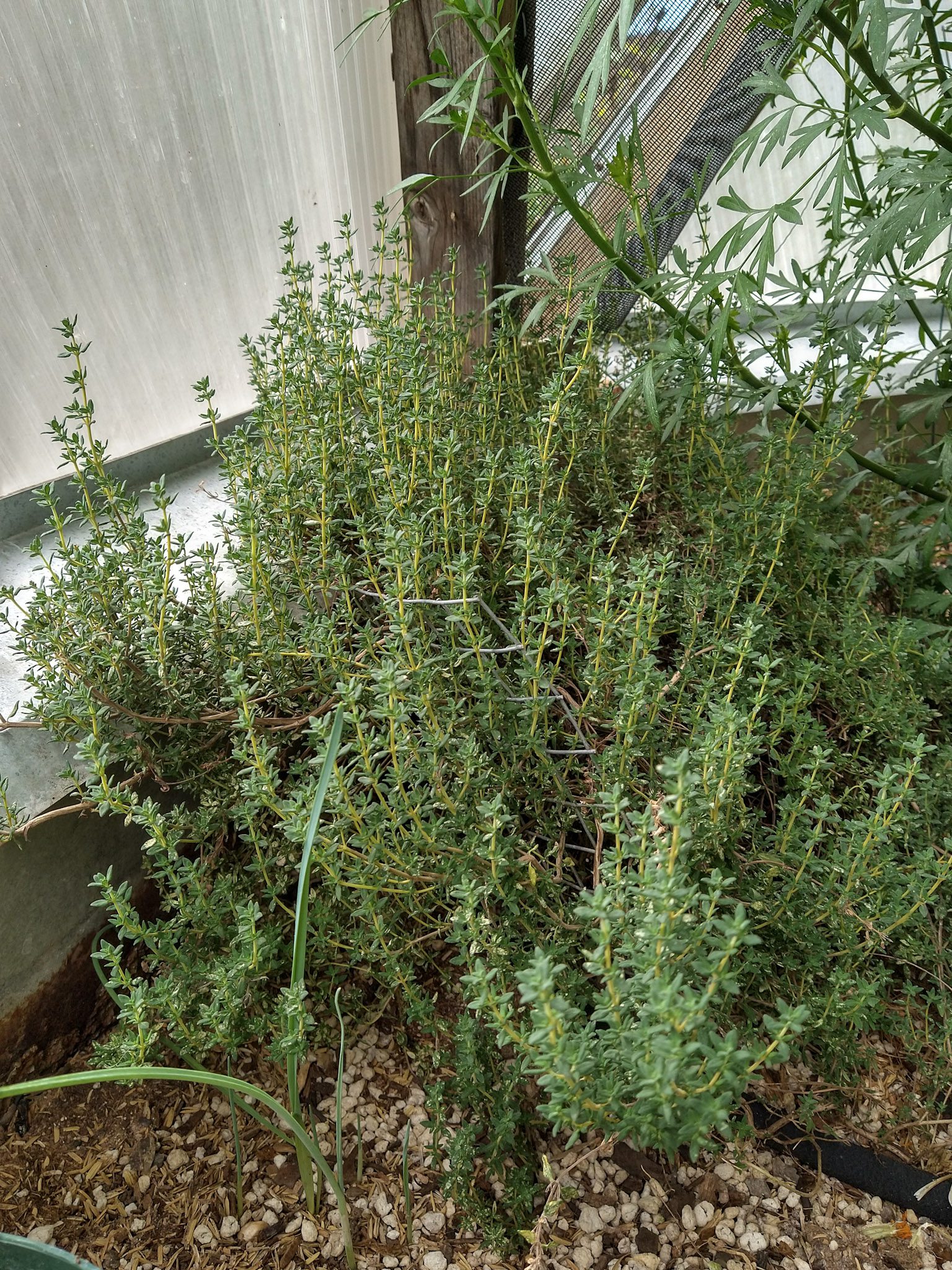To grow thyme, plant it in well-drained soil and place it in a sunny spot. Water sparingly to prevent root rot.
Thyme is a versatile herb that enhances many dishes with its earthy flavor. This perennial plant is easy to grow, making it perfect for both novice and experienced gardeners. Thyme thrives in well-drained soil and requires plenty of sunlight. It can be grown in garden beds or containers.
Once established, thyme requires minimal watering and maintenance. Regular harvesting encourages new growth, ensuring a continuous supply of fresh thyme. With its aromatic leaves and beautiful small flowers, thyme not only serves culinary purposes but also adds aesthetic value to your garden. Start growing thyme today to enjoy its many benefits.
Choosing The Right Thyme Variety
Choosing the right thyme variety is essential for a healthy herb garden. Different thyme varieties offer unique flavors and growth patterns. This section will guide you through some popular thyme varieties and their characteristics.
Common Thyme
Common thyme is a versatile herb used in many dishes. It has a robust flavor that enhances soups, meats, and stews. This variety is hardy and easy to grow.
- Scientific Name: Thymus vulgaris
- Height: 6-12 inches
- Spread: 12-18 inches
- Sunlight: Full sun
- Soil: Well-drained soil
Common thyme is drought-tolerant and thrives in sunny spots. It requires minimal care, making it ideal for beginners.
Lemon Thyme
Lemon thyme offers a citrusy twist on traditional thyme. It’s perfect for adding a fresh lemon flavor to fish, chicken, and salads. This variety is also visually appealing with its small, green leaves.
- Scientific Name: Thymus citriodorus
- Height: 6-12 inches
- Spread: 12-18 inches
- Sunlight: Full sun
- Soil: Well-drained soil
Lemon thyme is both ornamental and functional in the garden. It attracts bees, making it a good choice for pollinator gardens.
| Variety | Height | Spread | Sunlight | Soil |
|---|---|---|---|---|
| Common Thyme | 6-12 inches | 12-18 inches | Full sun | Well-drained soil |
| Lemon Thyme | 6-12 inches | 12-18 inches | Full sun | Well-drained soil |
Choosing the right thyme variety depends on your culinary needs and garden space. Both common thyme and lemon thyme are excellent choices for any herb garden.
Preparing The Soil
Thyme is a hardy herb that thrives in well-prepared soil. Getting the soil right is the first step to a bountiful thyme harvest. Let’s explore the essential aspects of soil preparation to grow thyme successfully.
Soil Type
Thyme grows best in light, well-draining soil. Sandy or loamy soil types work wonders for this herb. Heavy, clay-rich soils can hinder thyme’s growth. They hold too much water and cause root rot.
Here’s a quick guide to soil types:
| Soil Type | Characteristics |
|---|---|
| Sandy Soil | Light, well-draining, dries quickly |
| Loamy Soil | Balanced texture, good drainage, nutrient-rich |
| Clay Soil | Heavy, retains water, poor drainage |
Mixing compost or sand into the soil can improve its texture. This ensures better drainage and provides thyme with the ideal growing conditions.
Ph Levels
Thyme prefers soil with a neutral to slightly alkaline pH level. The ideal pH range for thyme is between 6.0 and 8.0. Testing your soil’s pH level is simple and can be done with a soil test kit.
Follow these steps to adjust your soil’s pH:
- Test the soil pH using a soil test kit.
- For acidic soil (pH below 6.0), add lime to raise the pH.
- For alkaline soil (pH above 8.0), add sulfur to lower the pH.
- Retest the soil after amendments to ensure the pH is within the ideal range.
Maintaining the correct pH level helps thyme absorb nutrients effectively. This leads to healthier and more robust plants.
Planting Thyme
Thyme is a versatile herb that enhances many dishes. Growing thyme at home is easy. It requires minimal care and thrives in various conditions. Let’s explore the best methods for planting thyme.
Seed Vs. Seedlings
Growing thyme from seeds is cost-effective. It requires patience since seeds take time to germinate. Planting seedlings offers quicker results. Seedlings are young plants ready for transplanting.
| Seeds | Seedlings |
|---|---|
| Cost-effective | Quick results |
| Longer germination time | Ready to transplant |
| Requires patience | Less waiting time |
Planting Depth
Thyme seeds need light to germinate. Do not bury them too deep. Sprinkle seeds on the soil surface and press gently. Cover them with a thin layer of soil or vermiculite.
Seedlings should be planted at the same depth they were in their pots. Ensure roots are covered, but the stem remains above ground.
Planting Thyme is simple with the right steps. Choose between seeds and seedlings. Ensure proper planting depth for healthy growth.

Credit: homesteadingfamily.com
Watering Techniques
Proper watering techniques are vital for growing healthy thyme. This section will cover the frequency and methods for watering thyme effectively.
Frequency
Thyme requires consistent watering but doesn’t like to be overwatered. Here is a simple guide:
- Seedlings: Water daily until established.
- Mature Plants: Water once a week.
- During Drought: Increase frequency to twice a week.
Check the soil moisture regularly. If the top inch is dry, it’s time to water.
Watering Methods
Choosing the right watering method ensures thyme gets the right amount of moisture.
| Method | Description |
|---|---|
| Drip Irrigation | Slowly delivers water directly to the soil. Prevents leaf diseases. |
| Soaker Hose | Distributes water evenly across the garden bed. Saves water. |
| Hand Watering | Allows for targeted watering. Avoids water waste. |
Always water thyme at the base. Wet leaves can lead to mold and mildew.
Morning is the best time for watering. It allows the soil to absorb moisture.
Pruning Thyme
Pruning thyme is essential for maintaining a healthy and productive herb garden. Regular pruning encourages new growth, ensures the plant remains tidy, and prevents it from becoming woody. Let’s explore the best practices for pruning thyme to keep your herb garden thriving.
When To Prune
The ideal time to prune thyme is during the growing season. This is usually in the spring and summer. Pruning during this period promotes vigorous growth and a bushier plant.
Spring Pruning: In early spring, prune any dead or damaged stems. This helps the plant focus its energy on new growth.
Summer Pruning: Lightly trim the plant throughout the summer. This encourages continuous growth and prevents the thyme from becoming too woody.
Pruning Tools
Using the right tools ensures clean cuts and minimizes damage to the plant. Here are some essential tools for pruning thyme:
- Pruning Shears: These are ideal for cutting thicker stems. Ensure they are sharp and clean.
- Scissors: Use for trimming softer, more delicate stems. Keep them sharp to avoid crushing the plant.
- Gloves: Protect your hands from any sharp stems or thorns.
Here is a quick reference table for pruning tools:
| Tool | Use |
|---|---|
| Pruning Shears | Thicker Stems |
| Scissors | Softer Stems |
| Gloves | Hand Protection |
Remember to disinfect your tools before and after use. This prevents the spread of disease.
Follow these guidelines to keep your thyme healthy and productive. Happy gardening!
Pest And Disease Management
Growing thyme can be a rewarding experience. But, it is crucial to manage pests and diseases effectively. Proper management ensures your thyme remains healthy and productive. Below, we explore common pests and ways to prevent diseases.
Common Pests
Thyme plants can attract various pests. The most common ones include:
- Aphids: These tiny insects suck sap from the leaves.
- Spider Mites: They cause yellow spots on leaves.
- Whiteflies: These pests leave a sticky substance.
To control these pests, consider using natural predators like ladybugs. You can also use insecticidal soap for severe infestations.
Disease Prevention
Thyme is generally disease-resistant. But certain conditions can lead to problems. Here are some tips for disease prevention:
- Proper Spacing: Ensure plants have enough space. This improves air circulation and reduces fungal growth.
- Well-Drained Soil: Thyme prefers well-drained soil. Avoid waterlogged conditions to prevent root rot.
- Regular Inspections: Check plants regularly for signs of disease. Early detection helps in managing issues swiftly.
By following these tips, you can keep your thyme plants healthy and thriving.
Harvesting Thyme
Harvesting thyme is a crucial step in enjoying this aromatic herb. Proper harvesting ensures the best flavor and growth.
Optimal Harvest Time
Thyme is best harvested just before it blooms. This is when the leaves are most flavorful.
Morning is the ideal time to harvest. The essential oils are most concentrated then.
Make sure the plants are dry before you cut them. Wet leaves can mold easily.
Harvesting Methods
There are a few methods to harvest thyme:
- Hand-picking: Use your fingers to pluck the leaves gently.
- Shearing: Use scissors or shears to cut stems.
When using scissors, cut stems back to about 5 inches. Avoid cutting into the woody part of the plant.
Leave some leaves on the plant so it can continue growing. This encourages new growth.
After harvesting, rinse the thyme leaves under cool water. Pat them dry with a paper towel.
| Method | Tools Needed | Best For |
|---|---|---|
| Hand-picking | None | Small amounts |
| Shearing | Scissors or Shears | Large harvests |
Store the harvested thyme in a cool, dry place. You can also freeze or dry the leaves for later use.

Credit: growingspaces.com
Storing And Using Thyme
Thyme is a versatile herb. It enhances many dishes with its unique flavor. Proper storage ensures its longevity and potency. Here’s how to store and use thyme effectively.
Drying Thyme
Drying thyme is simple and preserves its flavor for months.
- Harvest: Cut fresh thyme stems.
- Wash: Rinse in cold water and pat dry.
- Bundle: Tie stems into small bundles.
- Hang: Hang bundles in a dry, dark place.
- Wait: Let dry for 1-2 weeks.
- Store: Remove leaves and store in airtight containers.
Culinary Uses
Thyme adds a delightful flavor to various dishes. Here are some common uses:
- Soups: Add to chicken or vegetable soups.
- Meats: Rub on steaks, chicken, or lamb.
- Vegetables: Sprinkle over roasted veggies.
- Stews: Enhance beef or vegetable stews.
- Sauces: Mix into tomato or cream sauces.
Thyme is also a great addition to marinades and dressings. Its robust flavor can transform any meal.
Storage Tips
Proper storage keeps thyme fresh and flavorful.
| Storage Method | Duration | Details |
|---|---|---|
| Fresh | 1-2 weeks | Wrap in a damp paper towel and place in a plastic bag. |
| Dried | 6 months | Store in an airtight container in a cool, dark place. |
| Frozen | 6 months | Freeze leaves in ice cube trays with water or oil. |
Using these methods, you can enjoy thyme year-round.
:max_bytes(150000):strip_icc()/grow-thyme-indoors-1902495-02-6cfdad3b59e14b4187b348453f280a82.jpg)
Credit: www.thespruce.com
Frequently Asked Questions
How Much Sunlight Does Thyme Need?
Thyme needs full sunlight to thrive. Aim for at least 6-8 hours of direct sunlight daily.
How Often Should I Water Thyme?
Water thyme when the soil is dry. Over-watering can harm thyme. Aim for once a week.
Can Thyme Grow Indoors?
Yes, thyme can grow indoors. Ensure it gets enough sunlight and well-drained soil.
What Soil Is Best For Growing Thyme?
Thyme grows best in well-drained, sandy, or loamy soil. Avoid waterlogged conditions for optimal growth.
Conclusion
Growing thyme is simple and rewarding. With proper care, you can enjoy fresh thyme year-round. Just remember to provide sunlight, well-drained soil, and occasional watering. This hardy herb thrives with minimal effort, making it perfect for any garden. Start growing thyme today and elevate your culinary dishes with homegrown flavor.
